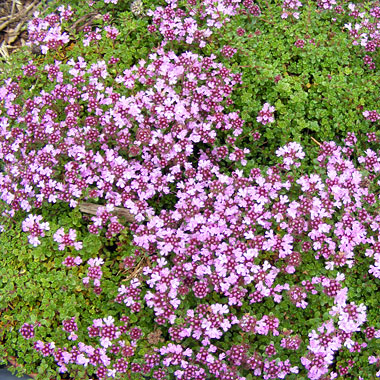


Thyme Russetings
Thymus serpyllum 'Russetings'

This is one of the most reliable and hardiest of creeping thymes.
In common with other thymes it prefers poorish conditions and warm sun – any situation which is not soggy or shaded.
The lighter and more gravelly the soil the better, thymes grown in heavier soils tend
to be less aromatic and have a poorer display of flowers.
It is ideal when included in a mixed planting for a thyme path or lawn,
or cascading over a rockery or the side of a container.
The deep green leaves take on a bronze sheen in the coldest weather
and it makes an attractive ground cover throughout the year.
It is aromatic to the touch and will withstand walking on when planted up on paths and in gravelled areas.
It can be planted alongside our other creeping thymes to give contrasts of flower colour and foliage texture.
The foliage is smothered in dark pink flowers in early summer
and which are a strong lure for all of the bees in the neighbourhood.
As with all thymes it is important to trim it back soon after flowering,
this encourages lots of new shoots and often a second flowering period in the autumn.
Thyme is on of the most popular herbs worldwide.
Within the genus Thymus there are upwards of 350 different species
and this huge diversity of thymes are all in some way aromatic, some more than others.
Thymes have always played a large part in history and folklore.
Thymus is derived from the greek Thymon meaning courage.
Ancient Greeks used thyme to perfume their knees and throats
and the Romans bathed in waters containing essence of thyme to give them vigour.
They also flavoured both liqueurs and cheese with thyme and gathered it as fodder for their animals.
In comparatively more recent times, ladies in the Middle Ages embroidered thyme sprigs onto favours
to give courage to their chosen knights.
The Scots of the same period drank thyme teas to give courage and strength in battle.
Thyme is well known for it’s antiseptic and preservative properties.
This is documented as far back in time as the Egyptians
who used it in the embalming process and for general preservation of all types of specimens and records against mildew.
Medically thyme has been used for its digestive and antiseptic properties
and in the present day thymol - extracted from thyme leaves - is used in cough medicines.